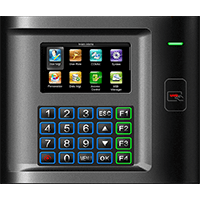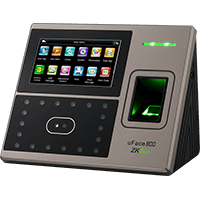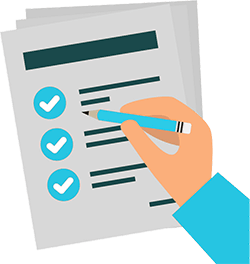How to choose the best time clock for your business
Time clocks are used by businesses around the globe to record how many hours their employees work. Since their invention, they have become so much more than machines that punch time cards. There are multiple different systems, each offering their own unique solution. Simply put, choosing the right time clock solution for your business can save you money, by saving you time.
With so many different time clock variations, how do you decide which model or version is best for you?
The team at Midex Software has been helping timekeepers save time (and money) for 15 years. We partner with some of the world’s largest manufacturers of time and attendance clocks to provide you with the solution that best suits your needs today; and positions you for growth tomorrow.
We’ve broken down what you need to look at into 4 parts:
- Biometric vs non-biometric
- Features
- Environment
- Budget
The first thing you need to figure out is whether you need a biometric or non-biometric time clock.
Biometric vs. non-biometric time clocks
 Non-biometric clocks are typically card readers, coming in different shapes and sizes. They make it possible for employees to punch in and out using an assigned identification number. They are cheap, easy to maintain, easy to set up, and can be integrated into your desktop or web-based Time and Attendance software.
Non-biometric clocks are typically card readers, coming in different shapes and sizes. They make it possible for employees to punch in and out using an assigned identification number. They are cheap, easy to maintain, easy to set up, and can be integrated into your desktop or web-based Time and Attendance software.
Unfortunately, one of the main drawbacks of their simplicity results from “buddy punching” and/or “ghost workers”. Why? Because it’s easy for anyone to punch someone else’s card or number. Individual cards/fobs can also create unwanted issues, which can be lost or stolen, costing you money and putting your
business at risk. If you’ve encountered any of these problems, consider a biometric time clock.

Biometric time clocks track a unique physical characteristic of an employee like the geometry of their hand, fingerprints or
facial recognition points. With these systems, you no longer have to worry about replacing expensive key cards, keeping paper cards in inventory or time theft. Employees spend less times at the device, can clock in or out faster and you save money. However, not all biometric time clocks may be right for your business. If employees work in a dirty, dusty or oily environment, then a fingerprint reader may not be ideal. Dirty fingers will not only be tough to scan, but will also leave residue on the system preventing other employees from using the time clock.
Device features

Not all devices are built the same. Some will come with features you don’t need, and others will lack features important to you. Consider these factors:
Employees
Some devices can support more than 30,000 employees, while others support employee sizes as low as 50. How many employees will be using the time clock matters for 2 main reasons:
Business Growth

Does your company plan on expanding in the future? Your time clock may be able to support all the employees you currently have, but it should also support all the employees you plan to have as your business grows.
Efficiency
Your device may be able to support the thousands of employees you have, but if hundreds of them need to use your time clock at the same time, it could create chaos when they all need to punch in/out together. For example, if 100 employees finish work at 4 and it takes 20 seconds for each employee to punch out, you’re losing over 30 minutes of productivity every day. Don’t forget to factor in the overall time it takes to change shifts. How much overlap is required as one shift ends and the other begins? If either of these scenarios seems all too familiar, consider purchasing several time clocks, which will quickly pay for themselves… in time.
Data
Are you comfortable downloading data logs every week or does this task take up too much time – and money?
When employees register at the time clock, a time log is created which tracks and stores the employee’s number and when they registered to the device. Once downloaded on a computer, attendance logs are saved onto a database which can be viewed by you at any time.
The amount of data that can be stored on a device before it needs to be downloaded varies. Some devices can store up to 100,000 registrations, while others limited to 5,000 or less. This may not be a problem if your device in the facility and logs can be pulled every 15-30 minutes to your time and attendance software. However, if you plan to install the time clock somewhere at a remote location and will be extracting time logs once a week, you need to consider the number of employees and how many times a day they would punch in before the memory becomes full.
Devices also differ in how attendance logs are downloaded. Some systems require software to be run on a local computer, which periodically downloads your logs, for example every 15-30 minutes. Other devices don’t require this and can upload your logs directly into your Time and Attendance software in real-time, no matter whether it’s hosted locally or in the cloud.
Connection and Installation
How will your time clock connect to your computer?
Common types of connections are Serial/USB, or a Network.
Serial or USB connectors use a cable to connect the device to the computer. With cables, you need to consider their length as well as the number of ports available on the computer which the device is hooked up. If multiple devices are needed, you need multiple ports… or multiple computers.
A device with a network card allows the reader to be installed anywhere in your facility. This option may be more expensive, but it allows an endless number of devices to be connected to your network.
Backup Battery
Do you need your time clock up and running constantly? Even during a power outage?
Have you ever encountered a situation where your employees were unable to punch in or out due to power failure?
Consider connecting your device through a regular UPS (uninterruptible power supply). Some devices even have built in back-up batteries to keep your device running during power outages.
At Midex Software, we offer a variety of Time Clocks, ranging from basic, non-biometric card readers, up to more sophisticated biometric time clocks (fingerprint readers, facial readers, and hand readers). Compare time clocks here.
Work environment
What’s your work environment like?
The same fingerprint reader which works for a clean retail store may not be ideal for a construction site.
Maybe a face reader, or a HandPunch device (a time clock which analyzes an employee’s hand geometry) may better suit your business needs.
Climate
Can your device withstand the environmental conditions in which it is placed?
Different devices are built to handle unique climate conditions. Not all devices can function in humidity, or temperatures that dip well below freezing, both common at outdoor facilities like construction sites.
Budget
 How much money can you – or are willing to – spend on your device? It’s important to balance your business needs today, as well as future growth plans, with the cost of the device. While the price may increase as you add on features onto your device, the time and money saved with automated solutions, multiple devices and custom integrations can be quickly recouped.
How much money can you – or are willing to – spend on your device? It’s important to balance your business needs today, as well as future growth plans, with the cost of the device. While the price may increase as you add on features onto your device, the time and money saved with automated solutions, multiple devices and custom integrations can be quickly recouped.
At Midex Software, our time clock solution can be customized to suit your business needs, save you money and increase productivity. Whether it be a biometric time clock that supports 50 employees and stores 5120 transactions, or a non-biometric time clock that connects to your computer through a network adaptor and has a backup power supply, there’s a solution for you. All of our time clocks come with free software, so you can manage the device remotely and extract attendance logs.
ROI
 Midex Time Control, our cloud-based Time and Attendance software, helps you get the most out of your new time clock. After all, the time clock itself has one function – it identifies an employee and logs the time they registered.
Midex Time Control, our cloud-based Time and Attendance software, helps you get the most out of your new time clock. After all, the time clock itself has one function – it identifies an employee and logs the time they registered.
Midex Time Control interprets this information and produces usable data to reduce payroll processing time, reclaim stolen hours, manage overtime, and eliminate manual input – and the human error that comes along with it.
Whether it’s integrating Time Clocks with your current Time and Attendance software or with Midex Time Control, our team of experts can help you customize your solution, as well as provide IT consulting and support.
At Midex Software, we’re here to help you create a roadmap to your ideal Time and Attendance solution. Contact us today.

